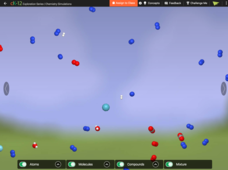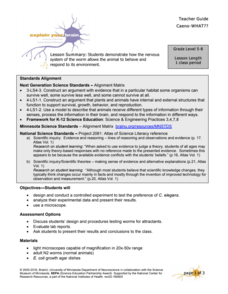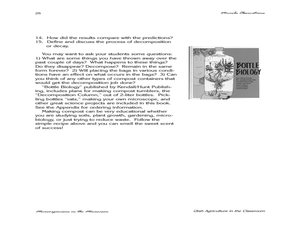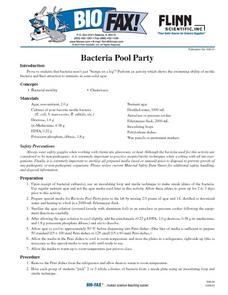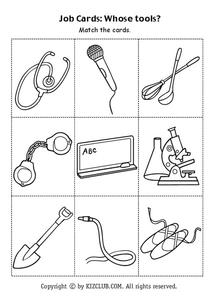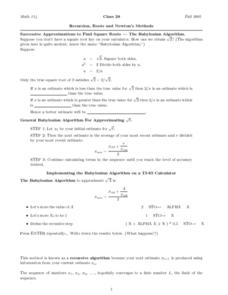CK-12 Foundation
Air Matters
What makes up the air we breathe? Young scientists explore the atoms and molecules in the air. An interactive lesson allows individuals to watch the movement of the particles in the air and change the makeup from a mixture to a compound....
National Nanotechnology Infrastructure Network
The Micro and Macro World Around Us
Don't let your eyes play tricks on you ... use scale to keep your eyes in check! Young scholars observe images without scale and try to identify the structure. Then, they look at the same image with a scale bar and assess whether their...
Serendip
Genetic Engineering Challenge – How Can Scientists Develop a Type of Rice That Could Prevent Vitamin A Deficiency?
Brown rice contains vitamins B and E, while white rice lasts longer in storage. The availability of rice around the world makes it a great candidate for genetic engineering. Scholars apply their knowledge of genetic engineering to solve...
University of Minnesota
Caeno-WHAT??
Can you feel that? Can you smell that? Since pupils can't ask worms about their sense of smell and touch, they design and complete an experiment to answer these questions. Individuals expose nematodes to different stimuli using their...
American Museum of Natural History
Gusty: The Gut Microbiome Card Game
Build up your gut. Groups up to four play a card game to learn more about the microbiome in the gut. Learners try to build a healthy gut with their cards. The player acquiring six microbes without any pathogens wins the game.
American Chemical Society
A Closer Look at Crystals
It's about to become crystal clear! Learners compare and contrast three different types of crystal substances. First they observe their structure and then investigate how they interact with various substances.
Alabama Learning Exchange
It's a Small, Small World
Students compare and contrast the different characteristics of animal-like, plant-like, and fungus-like protists. They list examples and describe the characteristics shared by the three protist groups. They create a brochure or slideshow...
Curated OER
Implicit Differentiation
In this implicit differentiation worksheet, students use the chain rule to solve for the derivative. The find the equation for the tangent line at a given point and determine if the line is vertical. This two-page worksheet contains...
Curated OER
Chemistry Far and Wide
In this chemistry worksheet, students fill in 10 blanks with the appropriate term, they determine if 4 statements are true or false, they match 6 terms with their definitions and they answer 3 questions. Topics include areas of chemistry...
Curated OER
Rotten Truth
Students complete activities to study decomposition. In this decomposition activity, students work in pairs to observe a decay buffet experiment. Students keep compost bag journals. Students define and discuss the process of decomposition.
Curated OER
How Does Cell Size And Shape Affect Transport of Materials
Tenth graders explore concepts of surface area, volume, and ratios, create spreadsheets to aid organization of data collected and provide graphing capabilities, and use NIH Imaging to enable calculations of microscopic organisms.
Curated OER
What Do Trees Do for Dinner?
Students investigate how trees produce their own food. They examine chlorophyll cells with a microscope, analyze a cross section of a log, determine how old the tree was, simulate the distance of the roots, and create a play.
Curated OER
Science: Suddenly Snow
Students engage in snow-related activities during the first winter snowfall. After explaining the elements needed for it to snow, they preserve snowflakes on frozen slides and observe them under a microscope. Then, they write diamante...
Curated OER
Are Fruits And Vegetables Really Made of Cells?
Students design and carry out an exercise to determine if a given fruit or vegetable is composed of cells. They dissect out sections of the fruit or vegetable, prepare stained slides, and make observations under a compound microscope.
Curated OER
The Shape of Things
Students study the natural incubation of hens and the important characteristics of the egg shell. They perform experiments to test the strength of the dome shape of an egg and prove that an eggshell has pores to allow air to pass. ...
Curated OER
Cell Pizza
Students identify parts and functions of microscope. Students watch video, Cells and Life about cell parts with actual pictures and actual cells. Students discuss video and identify parts of the cells that animals and plants have in...
Curated OER
Bacteria Pool Party
Students investigate the organisms of bacteria. They are given a culture of bacteria that can be observed under a microscope. The students make observations that are recorded. The lesson includes the mention of specific safety...
Curated OER
What Structures and Behaviours Can Be Observed in Vinegar Eels?
Students view vinegar eels under a microscope at different magnifications. They use a DigiScope with the camera attachment in place of the eyepiece. Students count the number of thrashing movements in 10 seconds. They repeat this three...
Curated OER
Pond Water
Students explore a creek environment. They make observations, identify the living and nonliving factors in the environment and collect a plankton sample to take back to the classroom. In addition, they look at plankton under a microscope.
Curated OER
Job Cards: Whose Tools?
In this jobs worksheet, students match the pictures with their correct words. All of the pictures illustrate a tool needed for a certain job, such as a microscope or chalkboard.
Curated OER
Recursion, Roots and Newton's Methods
In this recursion instructional activity, students determine the successive approximations of square roots by using the Babylonian Algorithm. They discuss how to derive Newton's Method from the microscopic approximation. This four-page...
Curated OER
Plant Structure and Function
Students examine the structure of Velcro and its function then relate it to seeds and seed stock. In this experimental lesson students test seed activity and what its function is for the plant, examine seeds under a microscope, and do a...
Curated OER
Animals: Worms
Students research the physical characteristics of mealworms and tubefex. In this worm lesson, students explore worms using a microscope. Students search their environment for worms.
Central Bucks School District
Igneous Rocks Lab
Searching for a simple igneous rocks experiment to assist pupils with rock classification based on texture and composition? In the activity, pupils view multiple rocks in various ways to determine texture and composition. They then...
Other popular searches
- Parts of a Microscope
- Compound Microscopes
- Label Compound Microscope
- Dissection Microscopes
- Microscope Cheek Cells
- Digital Microscope
- Microscope Lab
- Biology Lab Microscopes
- Scanning Electron Microscopes
- Cheek Cells and Microscopes
- Lesson Plan on Microscopes
- Lenses and Microscopes


